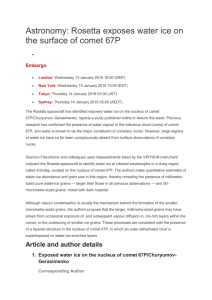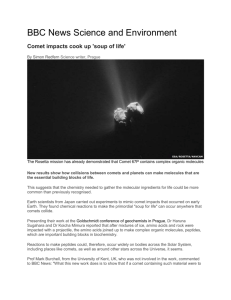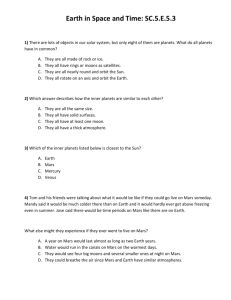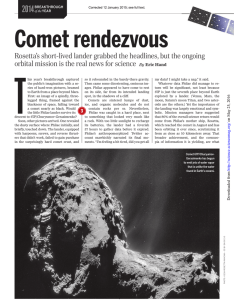friends of the planetarium newsletter
advertisement
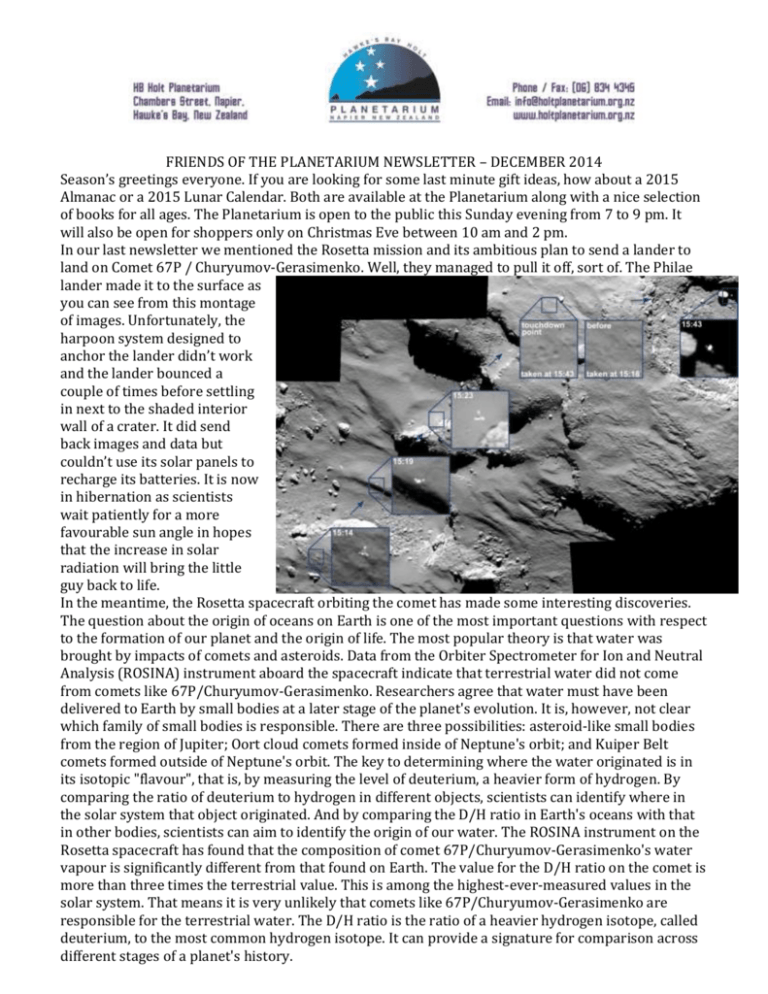
FRIENDS OF THE PLANETARIUM NEWSLETTER – DECEMBER 2014 Season’s greetings everyone. If you are looking for some last minute gift ideas, how about a 2015 Almanac or a 2015 Lunar Calendar. Both are available at the Planetarium along with a nice selection of books for all ages. The Planetarium is open to the public this Sunday evening from 7 to 9 pm. It will also be open for shoppers only on Christmas Eve between 10 am and 2 pm. In our last newsletter we mentioned the Rosetta mission and its ambitious plan to send a lander to land on Comet 67P / Churyumov-Gerasimenko. Well, they managed to pull it off, sort of. The Philae lander made it to the surface as you can see from this montage of images. Unfortunately, the harpoon system designed to anchor the lander didn’t work and the lander bounced a couple of times before settling in next to the shaded interior wall of a crater. It did send back images and data but couldn’t use its solar panels to recharge its batteries. It is now in hibernation as scientists wait patiently for a more favourable sun angle in hopes that the increase in solar radiation will bring the little guy back to life. In the meantime, the Rosetta spacecraft orbiting the comet has made some interesting discoveries. The question about the origin of oceans on Earth is one of the most important questions with respect to the formation of our planet and the origin of life. The most popular theory is that water was brought by impacts of comets and asteroids. Data from the Orbiter Spectrometer for Ion and Neutral Analysis (ROSINA) instrument aboard the spacecraft indicate that terrestrial water did not come from comets like 67P/Churyumov-Gerasimenko. Researchers agree that water must have been delivered to Earth by small bodies at a later stage of the planet's evolution. It is, however, not clear which family of small bodies is responsible. There are three possibilities: asteroid-like small bodies from the region of Jupiter; Oort cloud comets formed inside of Neptune's orbit; and Kuiper Belt comets formed outside of Neptune's orbit. The key to determining where the water originated is in its isotopic "flavour", that is, by measuring the level of deuterium, a heavier form of hydrogen. By comparing the ratio of deuterium to hydrogen in different objects, scientists can identify where in the solar system that object originated. And by comparing the D/H ratio in Earth's oceans with that in other bodies, scientists can aim to identify the origin of our water. The ROSINA instrument on the Rosetta spacecraft has found that the composition of comet 67P/Churyumov-Gerasimenko's water vapour is significantly different from that found on Earth. The value for the D/H ratio on the comet is more than three times the terrestrial value. This is among the highest-ever-measured values in the solar system. That means it is very unlikely that comets like 67P/Churyumov-Gerasimenko are responsible for the terrestrial water. The D/H ratio is the ratio of a heavier hydrogen isotope, called deuterium, to the most common hydrogen isotope. It can provide a signature for comparison across different stages of a planet's history. Comets are time capsules containing primitive material left over from the epoch when the sun and its planets formed. Rosetta's lander obtained the first images taken from a comet's surface and will provide analysis of the comet's possible primordial composition. Rosetta will be the first spacecraft to witness at close proximity how a comet changes as it is subjected to the increasing intensity of the sun's radiation. Observations will help scientists learn more about the origin and evolution of our solar system and the role comets may have played in seeding Earth with water, and perhaps even life. The search for evidence of a watery past on Mars continues as the Curiousity rover continues its journey up the slope of Mount Sharp in Mars’ Gale Crater. Observations by the rover indicate Mars' Mount Sharp was built by sediments deposited in a large lake bed over tens of millions of years. This interpretation of Curiosity's finds in Gale Crater suggests ancient Mars maintained a climate that could have produced long-lasting lakes at many locations on the Red Planet. Why this layered mountain sits in a crater has been a challenging question for researchers. Mount Sharp stands about 5 kilometers tall, its lower flanks exposing hundreds of rock layers. The rock layers, alternating between lake, river and wind deposits, bear witness to the repeated filling and evaporation of a Martian lake much larger and longer-lasting than any previously examined close-up. Curiosity currently is investigating the lowest sedimentary layers of Mount Sharp, a section of rock 150 meters high, dubbed the Murray formation. Rivers carried sand and silt to the lake, depositing the sediments at the mouth of the river to form deltas similar to those found at river mouths on Earth. This cycle occurred over and over again. After the crater filled to a height of at least a few hundred meters and the sediments hardened into rock, the accumulated layers of sediment were sculpted over time into a mountainous shape by wind erosion that carved away the material between the crater perimeter and what is now the edge of the mountain. Despite earlier evidence from several Mars missions that pointed to wet environments on ancient Mars, modeling of the ancient climate has yet to identify the conditions that could have produced long periods warm enough for stable water on the surface. NASA's Mars Science Laboratory Project uses Curiosity to assess ancient, potentially habitable environments and the significant changes the Martian environment has experienced over millions of years. This project is one element of NASA's ongoing Mars research and preparation for a human mission to the planet in the 2030s. Finding Earthlike planets beyond our solar system has largely been the work of space-based telescopes, but new observations from a remote island suggest that could change. The Nordic Optical Telescope on La Palma, one of the Canary Islands off the west coast of Africa, observed 55 Cancri e, a planet twice the size of Earth, as it passed in front of its parent star and caused a dip in the star's brightness, according to a new study. This is the first time a planet in this "super-Earth" size category orbiting a sunlike star has been observed by a ground-based telescope using this detection method, the researchers say. First identified in 2004 by a space-based telescope, 55 Cancri e has a diameter of about 26,000 kilometers, about twice that of Earth. The alien world is eight times as massive as Earth, making it a so-called super-Earth, a planet more massive than Earth but significantly smaller than gas giants like Neptune and Uranus. While not habitable, the planet's size and position around a sunlike star make it similar to planets that might support life, researchers say.




